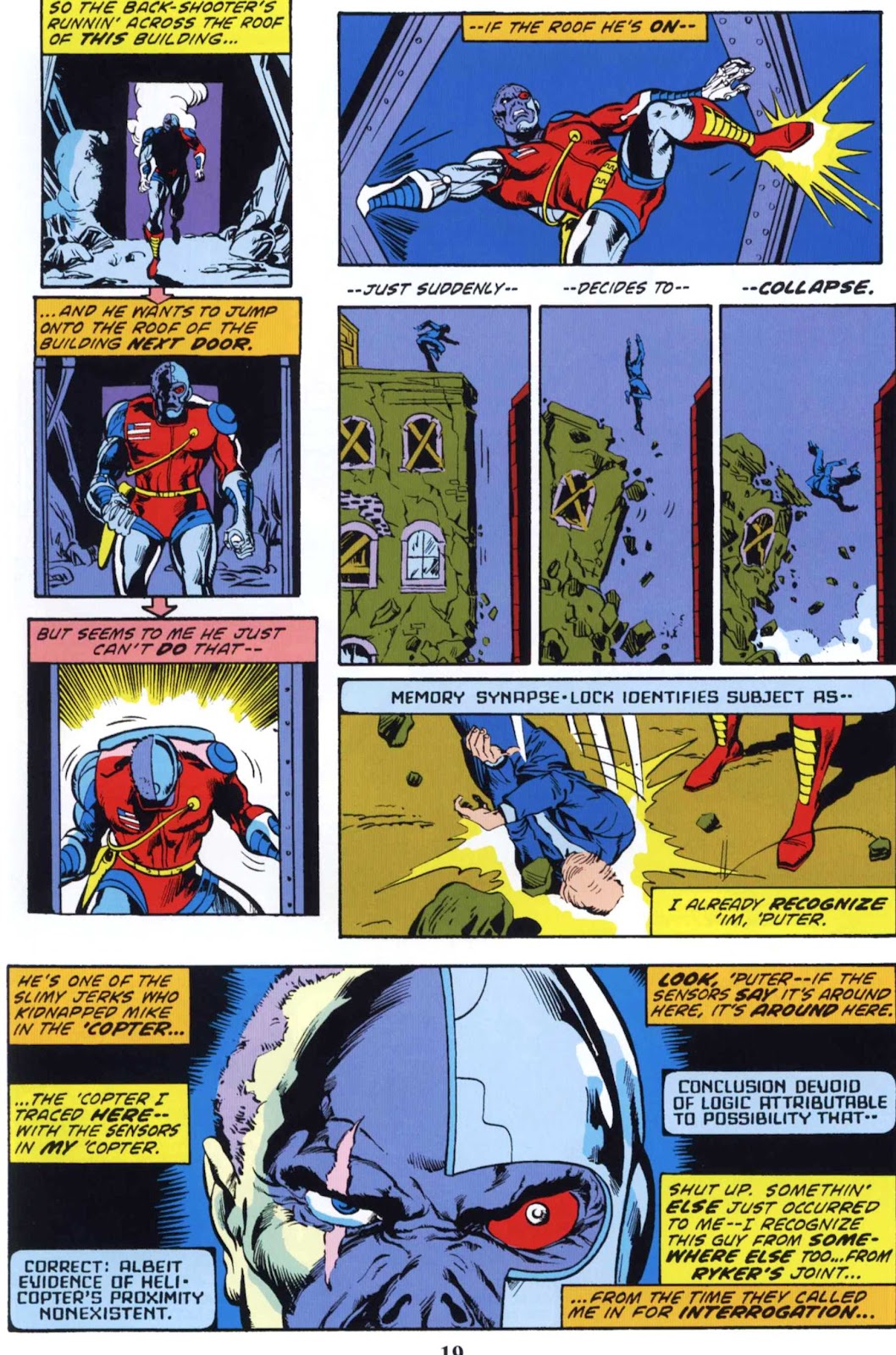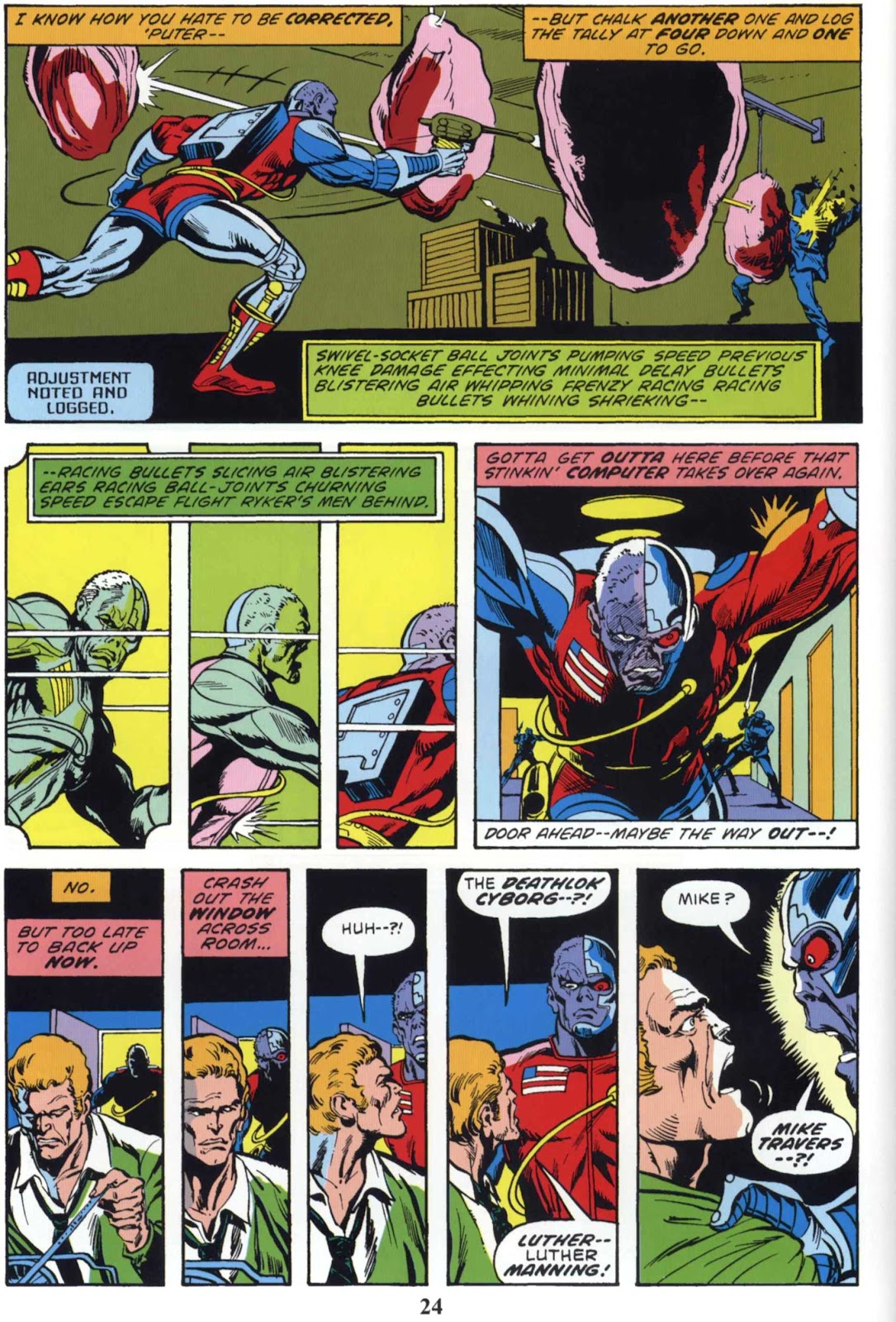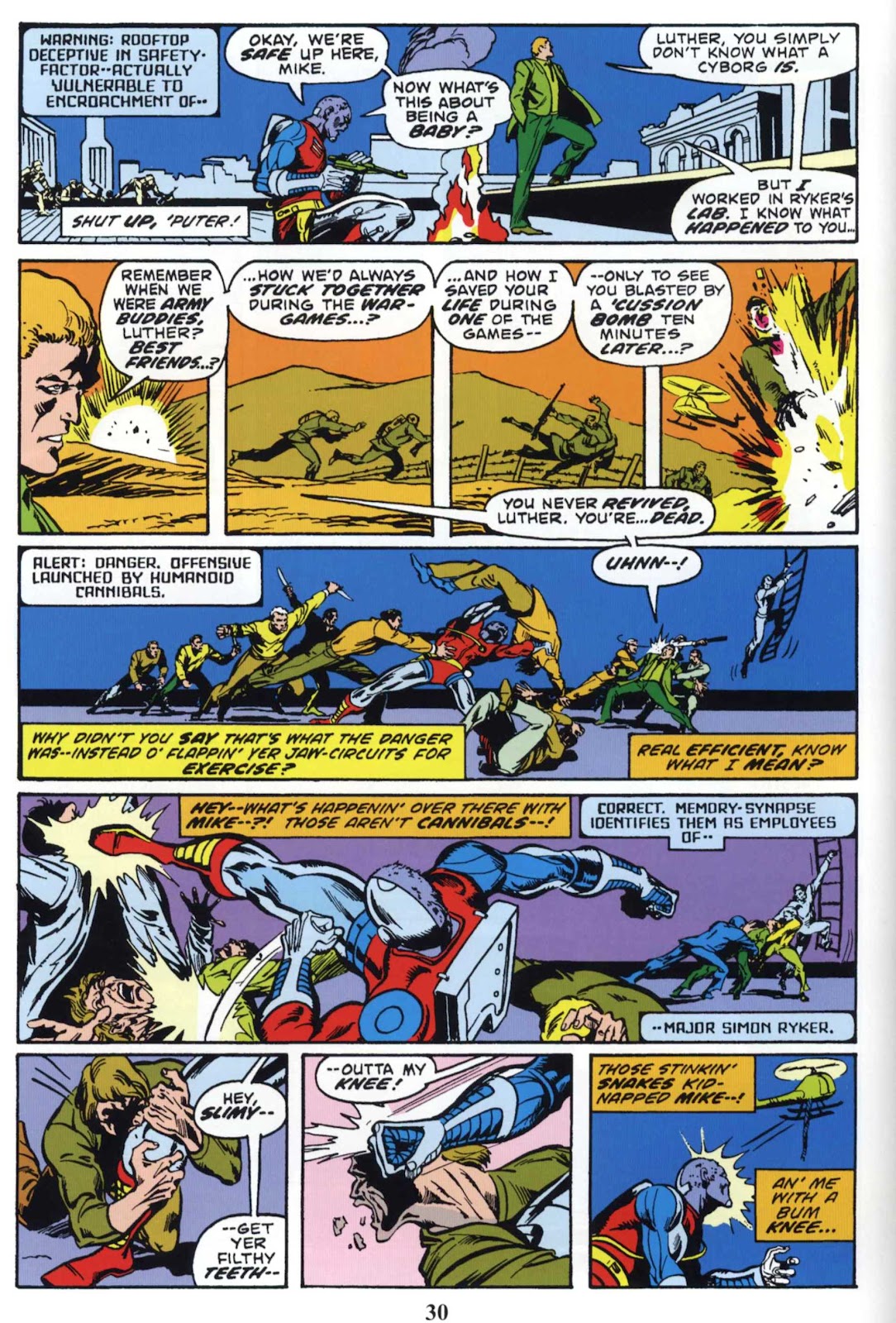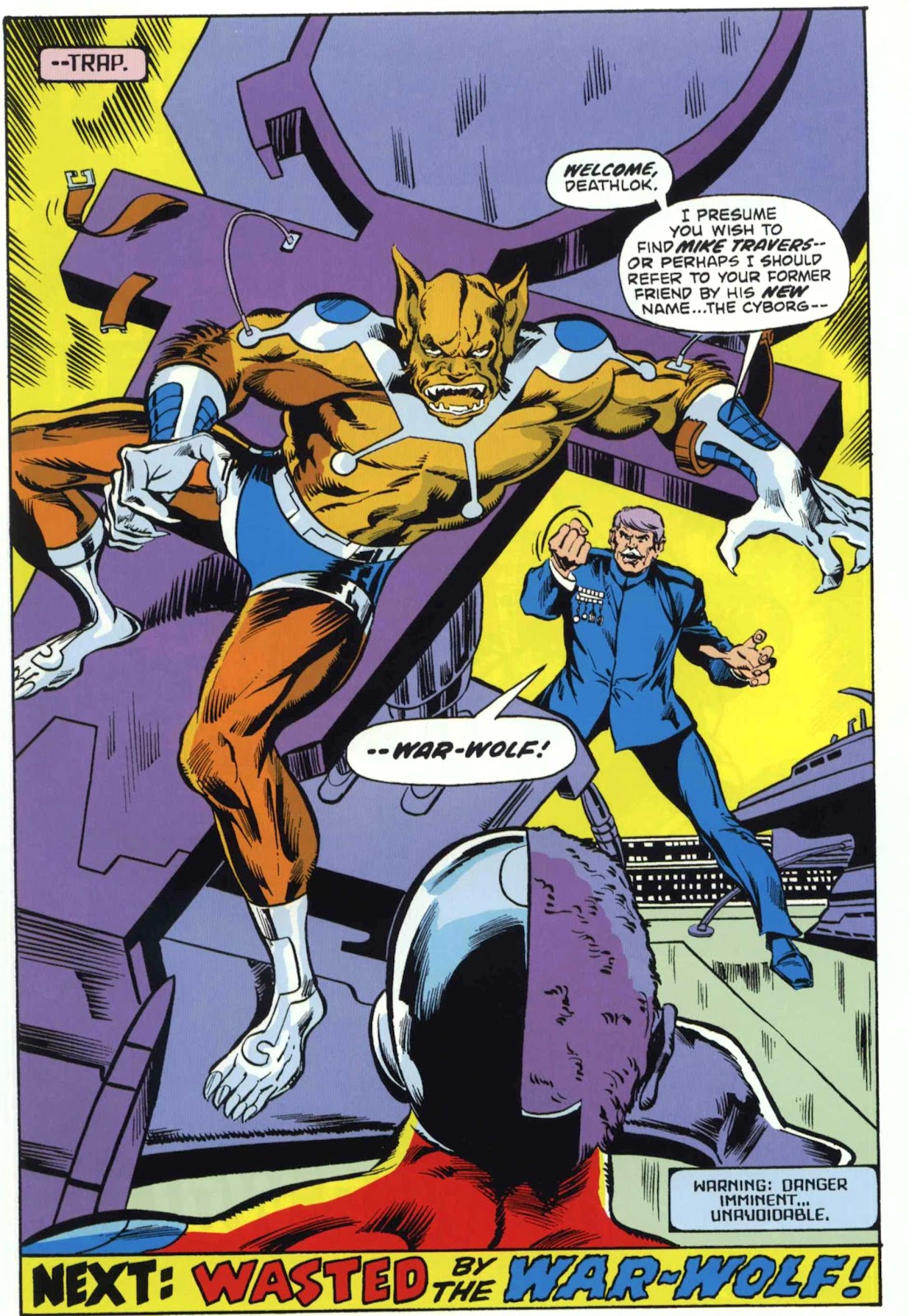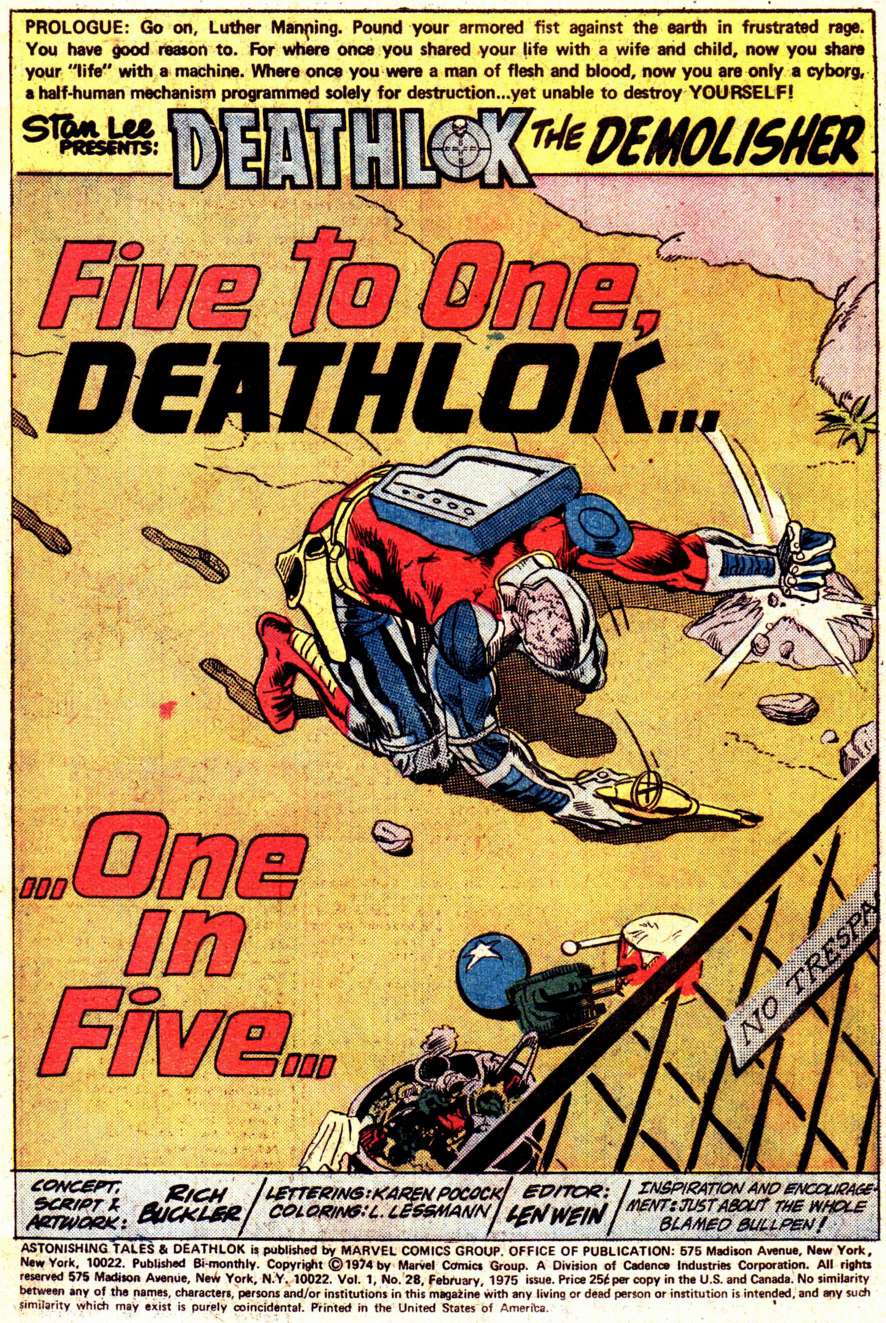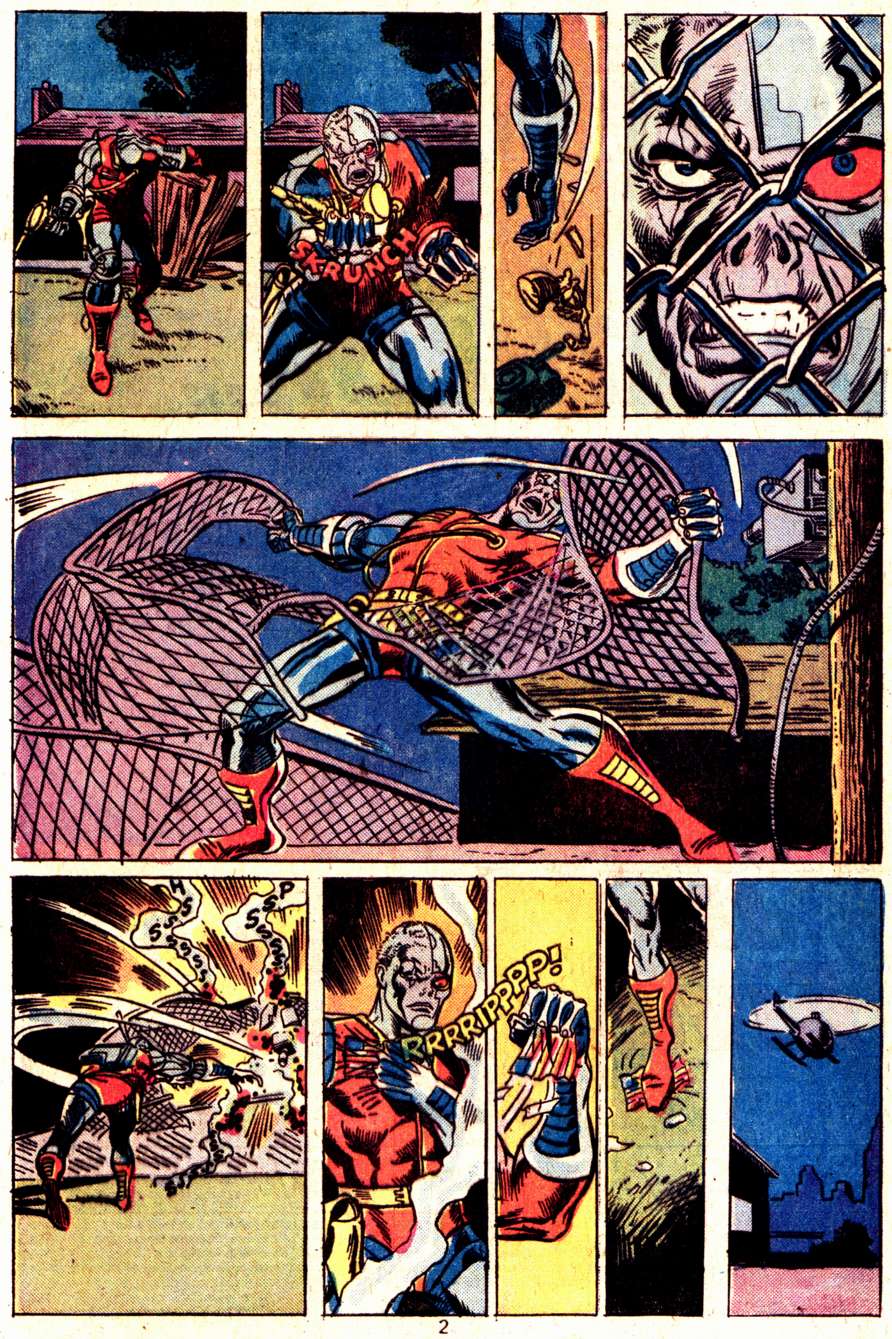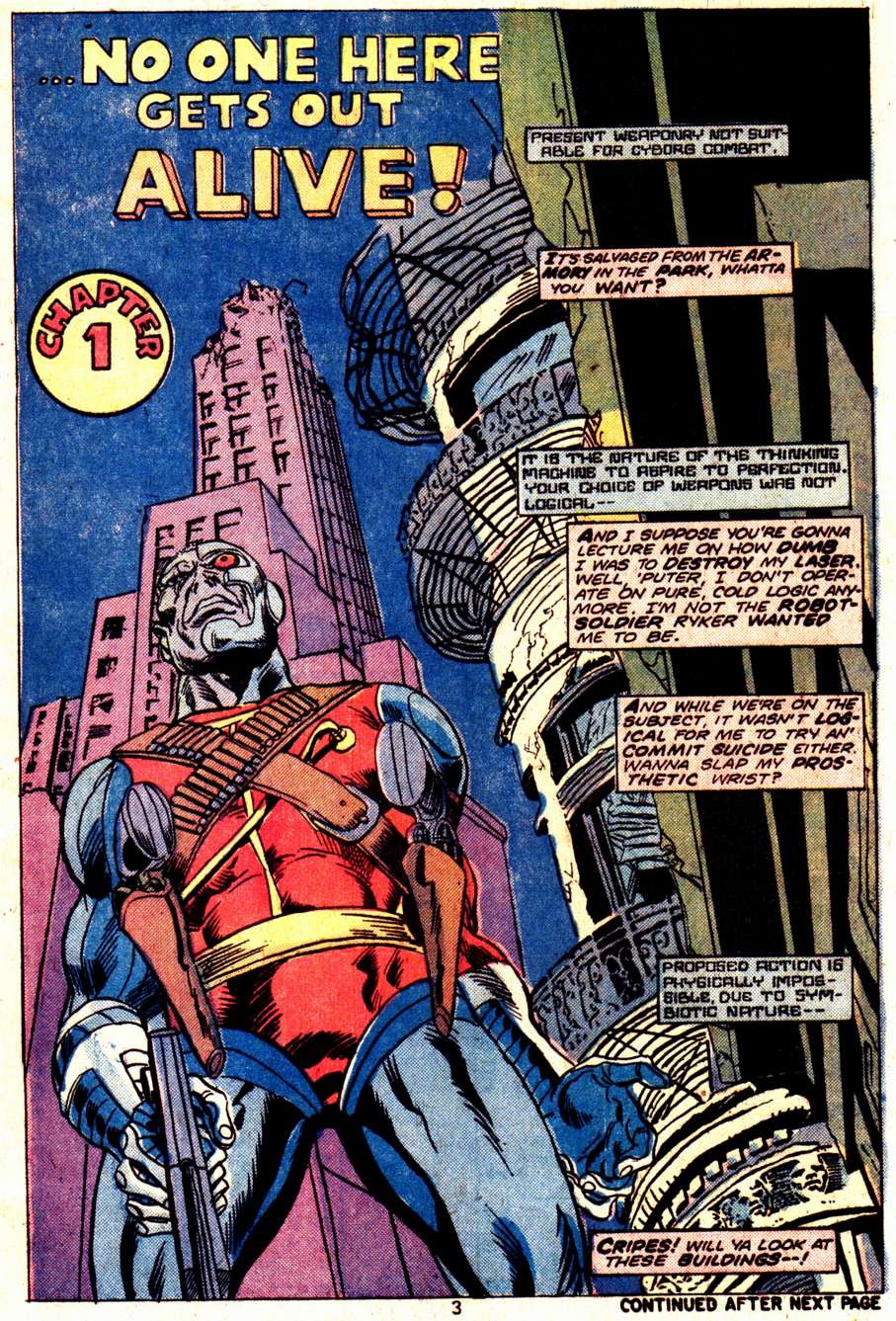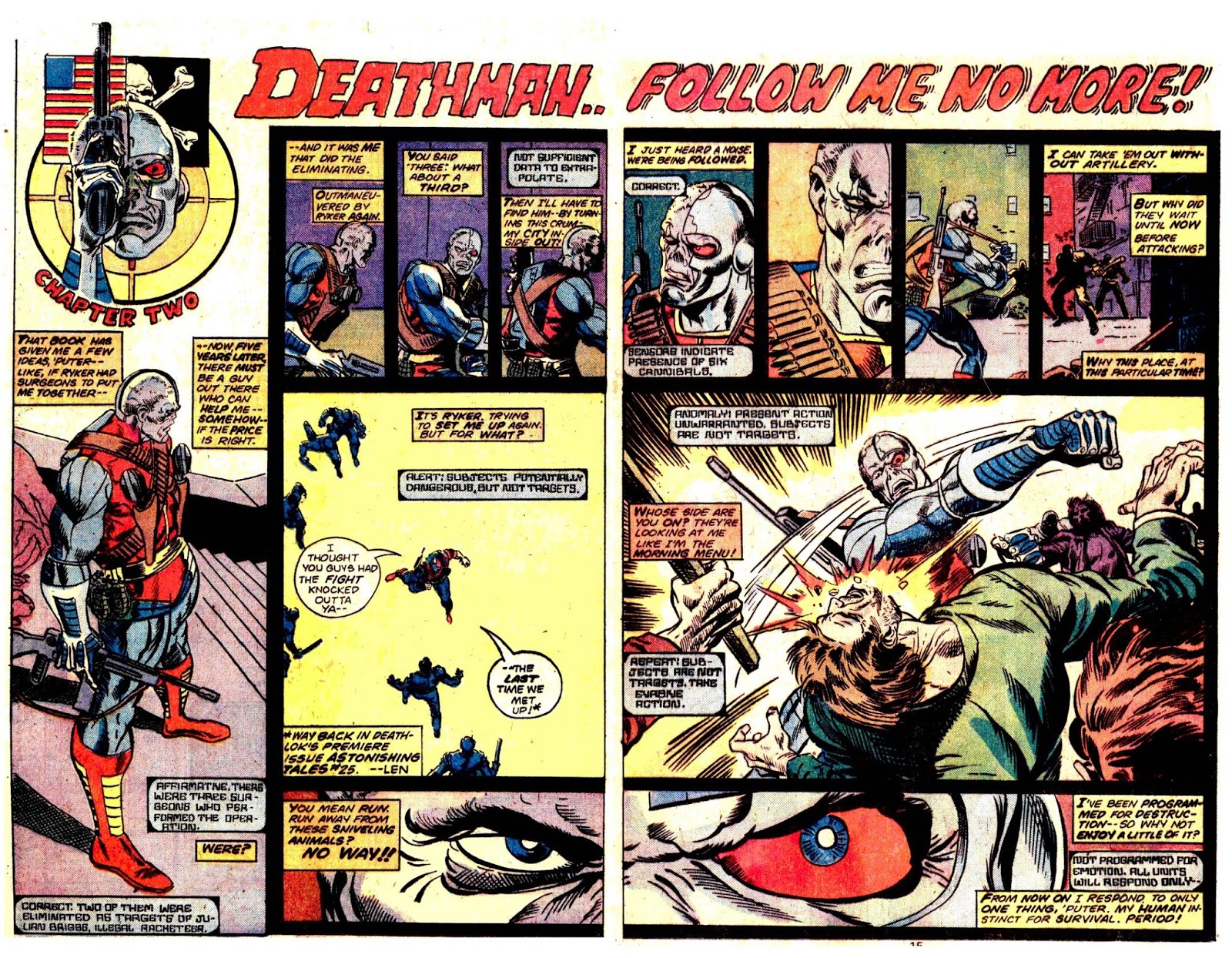Locked in Death-The Original Deathlok Saga
May 10, 2018 19:33:32 GMT -5
sabongero, brutalis, and 2 more like this
Post by codystarbuck on May 10, 2018 19:33:32 GMT -5
In 1972, the world of pop culture was introduced to the term "cyborg," a contraction of "cybernetic organism." Now, this wasn't exactly something new, as the world of sci-fi had dealt with the melding of man and machine, the brain and computers. Scientific research had been extensive in this field, which is what spawned its introduction to pop culture, via the novel, By Martin Caidin. Within that novel, we are introduced to Col. Steve Austin, astronaut and test pilot. Austin is testing an experimental lifting body prototype, when he is injured in a horrible crash. His body is rebuilt with mechanical prostheses, referred to as "bionics," in the novel. These additions allow him to perform superhuman feats and he becomes a special agent of the US government. The novel was adapted into a tv movie, in 1973, to high ratings and positive reviews. Two more tv movies would follow, then a regular series, lasting 4 seasons, with Lee Majors as Col. Austin.
Meanwhile, the comic book world was never one to pass up jumping on a bandwagon. In 1974, Marvel had announced that the next issue of their Worlds Unknown comic (which featured adaptations of sci-fi stories) would feature "Cyborg," a new, original story. It was not to be an adaptation of Caidin's novel nor the tv movies. However, that comic was canceled and the Cyborg project found a new home in Astonishing Tales.

That comic would introduce us to a nightmare future and a killing machine, known as Deathlok, the Demolisher. Although the concept is similar to Caidin's creation, it is only in the idea of a cyborg protagonist. Deathlok is a completely different take on the idea of man, melded with machine. It was also one of the most original ideas in a time of many original ideas (for comics). It was the brainchild of Rich Buckler, developed with Doug Moench, and it soon became a cult favorite and a favorite of mine. This thread will explore the stories of the original Deathlok, Luther Manning, from his debut here, up through guest appearances. It will not follow Michael Collins or others, as I want to focus on the original, more groundbreaking anti-hero and his nightmare world of 1990.
Astonishing Tales #25
Creative Team: Rich Buckler-creator, plotter and artist; Doug Moench-script, Glynis Wein-colors, Annette Kawecki-letters, Roy Thomas-editor.
Synopsis: Our first page gives us a nightmare image, of some monstrous creature, part dead flesh, part steel, armed with a futuristic weapon, taking aim at a terrified human...

The human runs and the monster follows his path, but does not fire. Computer instructions order him to fire........and he rebels. Another, cruder, almost human voice tells the computer that he wants to savor the kill. It takes pleasure from destroying the organic life...
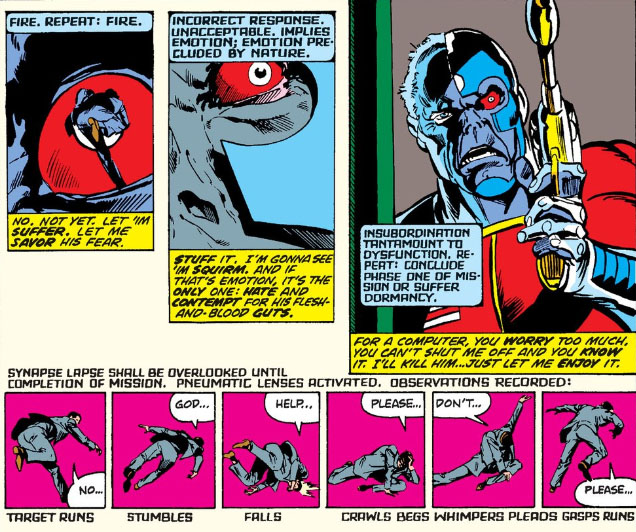
The monster finally fires, killing his prey. He then goes in search of his second target and meets him as he flees from some street thugs, blasting a hole through his torso.

We go into flash back, as we see shadowy, medical figures, pronounce a man dead, more or less. Major Simon Ryker asks if a portion of brain has been preserved and receives an acknowledgement. he orders Project: Alphamech to proceed, to the doctors' horror. We see as a computer is installed in his chest and destroyed portions of his body are replaced by flexible steel fibers. The brain is reinserted into the cranial cavity, which is partially cover by bone and part by steel plating. The monster rises from the table, it's face a mass of dead, scarred flesh, with one human eye and one red, mechanical eye. We leap back to the present as the monster reports in, while travelling via helicopter. He meets with the guards of a mobster, who hired him to kill the two targets. He defies computer instructions and smashes his way past the guards, as we flashback again, to see Maj Ryker observe the monster's testing, along with a woman. We learn the capabilities of the deceased Col. Luther Manning and how coded orders are fed to his CPU...

We learn of his weapons; a high powered laser pistol and a steel bayonet, attached magnetically to his right lower leg.
Back in the present, we see the monster use the weapons on the thugs, as he continues to defy computer instructions. He smashes through a wall and runs into a steel door, several inches thick. A voice warns the now-named Deathlok about trying to smash it and releases an anesthetic gas. We juxtapose to Deathlok suspended from machinery, being interrogated by Maj Ryker, about defying orders.

A robotic voice answers that rebellion is illogical, until a human, insubordinate voice takes over, while technicians note the computer readings are going wild. deathlok breaks free and smashes his way to a heliport and steals a helicopter. Back in the present, he smashes through the vault door and finds his prey, who refuses to pay him for his killings. He batters the man to death, only to reveal a robot, which feeds Ryker's voice to him, as the mobster was a ruse to manipulate Deathlok into killing two men who threatened the project. meanwhile, the woman, Nina, barges in and sees Ryker from behind, with mechanical components revealed at the back of her head. She realizes that Ryker is a cyborg and he insinuates her impending death.
Thoughts: Whoo boy; that was a hell of debut! Moench and Buckler grab you from that first splash page, as we see a modern take on the Frankenstein's Monster, armed with the weapons of the future, about to kill a human being. On the next page, we see the dichotomy of the computer instructions and the human brain, as this machine is taking pleasure in the killing or a normal human. This is not a cold, calculating Terminator; this is a human mind, capable of hatred and anger and rebellion. The back and forth between computer and human portions of the brain is what really made this series unique. The idea of a protagonist, who is a paid killer is not new, as it fell right into the anti-heroes that were blossoming in movies and television and in the world of men's adventure pulp novels. The paperback spinners were filled with Executioners and Destroyers and other gun-toting "heroes," while movies made heroes out of vigilantes, like Death Wish (appearing around the same time, but based on a 1972 novel). The sci-fi movie Westworld, from Michael Crichton, had treated us to robot killers gone amok. Moench and Buckler gave us the same on the four-color page.
Buckler conceived the idea and claimed to have been forming it for the past three years. He became aware of Caidin's novel, when Marvel was trying to acquire comic book rights to the Six Million Dollar Man. He says he was inspired to take his concept further away from Caidin's, to set their worlds apart, despite similar ideas. This is the same Rich Buckler who was reviled in the fan world for plagiarism, swiping poses and layouts from other artists. You have to decide for yourself whether Buckler had coincidentally come up with a cyborg story around the same time as Caidin or stole the idea, then tweaked it. The concepts, as played out, are vastly different; but, Buckler's had antecedents. Harlan Ellison's "The Soldier," a script for The Outer Limits, had featured a soldier in a nightmare future, who is thrust into the past, where his opponent soon turns up hunting him. Dystopian futures became a hot commodity in sci-fi, as the Cold War and the death count in the seemingly endless Vietnam War made people question whether man would survive the century. There was also the corruption within the Nixon government and secret government funded projects, dating back to previous administrations, revolving around mind control (of a sort), Nazi scientists, secret wars run by the CIA, and other paranoia. This was Doug Moench's world and he and Buckler bounced ideas off one another, developing Buckler's concept into Deathlok.
Moench is a superb pulp writer and he excelled at these kinds of heroes, as is demonstrated in Master of Kung Fu and Moon Knight, in addition to Deathlok. His writing is very cinematic and Buckler is right there with him. Buckler was still working on the Fantastic Four, where he was aping Kirby (and swiping from him). His style here is more his own, informed quite a bit by Neal Adams. The story itself gets a bit confusing, with the jumps back and forth in time, without strong visual separations for the two time periods. Reading it, it appears that Ryker's interrogation of Deathlok, with the cyborg in crucifixion pose, appears to follow right on with his coming to the steel door. It is only after he escapes the machinery that we see that it was the past, as he is bursting through the steel doors and confronting his employer. This time frame problem will remain a weakness in the series, as Buckler never really solves how to separate the time periods visually.
Moench's dialogue between the computer, or " 'puter," as Deathlok calls it, and Luther Manning's mind was unique. Mar-Vell and Rick Jones were sharing minds and having internal dialogues; but, this was different, as organic brain was jousting with cybernetic systems. One element does make a reader chuckle, in retrospect, as we see the coded orders are fed to deathlok via a slot on his forearm, via the method of computer punch card. It is hard to remember that this series preceded the home computer revolution and more sophisticated interfaces. A modern smart phone can do more than Deathlok's built-in computer, from his future of 1990. That is always a slippery slope in futuristic sci-fi. Science often moves faster than the author's imagination. Just ask Gene Roddenberry.
The issues itself ends with an editorial piece, with a conversation between Buckler, Moench, and Roy Thomas, talking about the conception of the project and the themes. there is also a parody piece about the creation, with Deathlok emerging from a waste basket, filled with discarded ideas, which is drawn by a very young George Perez, with Mike Esposito on inks. That was one of Perez's earliest pieces, at Marvel.
Deathlok remains Rich Buckler's one unique contribution to comics. He had some fine art, free of swiping from others; but, never had original ideas as he did here; nor did his art ever look as good. Doug Moench adds a lot and it seems to drive Buckler to work above past limits. he would do some great covers and fine interior work down the road; but, never escaped derivative ideas. Deathlok was his one real baby.
Meanwhile, the comic book world was never one to pass up jumping on a bandwagon. In 1974, Marvel had announced that the next issue of their Worlds Unknown comic (which featured adaptations of sci-fi stories) would feature "Cyborg," a new, original story. It was not to be an adaptation of Caidin's novel nor the tv movies. However, that comic was canceled and the Cyborg project found a new home in Astonishing Tales.

That comic would introduce us to a nightmare future and a killing machine, known as Deathlok, the Demolisher. Although the concept is similar to Caidin's creation, it is only in the idea of a cyborg protagonist. Deathlok is a completely different take on the idea of man, melded with machine. It was also one of the most original ideas in a time of many original ideas (for comics). It was the brainchild of Rich Buckler, developed with Doug Moench, and it soon became a cult favorite and a favorite of mine. This thread will explore the stories of the original Deathlok, Luther Manning, from his debut here, up through guest appearances. It will not follow Michael Collins or others, as I want to focus on the original, more groundbreaking anti-hero and his nightmare world of 1990.
Astonishing Tales #25
Creative Team: Rich Buckler-creator, plotter and artist; Doug Moench-script, Glynis Wein-colors, Annette Kawecki-letters, Roy Thomas-editor.
Synopsis: Our first page gives us a nightmare image, of some monstrous creature, part dead flesh, part steel, armed with a futuristic weapon, taking aim at a terrified human...

The human runs and the monster follows his path, but does not fire. Computer instructions order him to fire........and he rebels. Another, cruder, almost human voice tells the computer that he wants to savor the kill. It takes pleasure from destroying the organic life...

The monster finally fires, killing his prey. He then goes in search of his second target and meets him as he flees from some street thugs, blasting a hole through his torso.

We go into flash back, as we see shadowy, medical figures, pronounce a man dead, more or less. Major Simon Ryker asks if a portion of brain has been preserved and receives an acknowledgement. he orders Project: Alphamech to proceed, to the doctors' horror. We see as a computer is installed in his chest and destroyed portions of his body are replaced by flexible steel fibers. The brain is reinserted into the cranial cavity, which is partially cover by bone and part by steel plating. The monster rises from the table, it's face a mass of dead, scarred flesh, with one human eye and one red, mechanical eye. We leap back to the present as the monster reports in, while travelling via helicopter. He meets with the guards of a mobster, who hired him to kill the two targets. He defies computer instructions and smashes his way past the guards, as we flashback again, to see Maj Ryker observe the monster's testing, along with a woman. We learn the capabilities of the deceased Col. Luther Manning and how coded orders are fed to his CPU...

We learn of his weapons; a high powered laser pistol and a steel bayonet, attached magnetically to his right lower leg.
Back in the present, we see the monster use the weapons on the thugs, as he continues to defy computer instructions. He smashes through a wall and runs into a steel door, several inches thick. A voice warns the now-named Deathlok about trying to smash it and releases an anesthetic gas. We juxtapose to Deathlok suspended from machinery, being interrogated by Maj Ryker, about defying orders.

A robotic voice answers that rebellion is illogical, until a human, insubordinate voice takes over, while technicians note the computer readings are going wild. deathlok breaks free and smashes his way to a heliport and steals a helicopter. Back in the present, he smashes through the vault door and finds his prey, who refuses to pay him for his killings. He batters the man to death, only to reveal a robot, which feeds Ryker's voice to him, as the mobster was a ruse to manipulate Deathlok into killing two men who threatened the project. meanwhile, the woman, Nina, barges in and sees Ryker from behind, with mechanical components revealed at the back of her head. She realizes that Ryker is a cyborg and he insinuates her impending death.
Thoughts: Whoo boy; that was a hell of debut! Moench and Buckler grab you from that first splash page, as we see a modern take on the Frankenstein's Monster, armed with the weapons of the future, about to kill a human being. On the next page, we see the dichotomy of the computer instructions and the human brain, as this machine is taking pleasure in the killing or a normal human. This is not a cold, calculating Terminator; this is a human mind, capable of hatred and anger and rebellion. The back and forth between computer and human portions of the brain is what really made this series unique. The idea of a protagonist, who is a paid killer is not new, as it fell right into the anti-heroes that were blossoming in movies and television and in the world of men's adventure pulp novels. The paperback spinners were filled with Executioners and Destroyers and other gun-toting "heroes," while movies made heroes out of vigilantes, like Death Wish (appearing around the same time, but based on a 1972 novel). The sci-fi movie Westworld, from Michael Crichton, had treated us to robot killers gone amok. Moench and Buckler gave us the same on the four-color page.
Buckler conceived the idea and claimed to have been forming it for the past three years. He became aware of Caidin's novel, when Marvel was trying to acquire comic book rights to the Six Million Dollar Man. He says he was inspired to take his concept further away from Caidin's, to set their worlds apart, despite similar ideas. This is the same Rich Buckler who was reviled in the fan world for plagiarism, swiping poses and layouts from other artists. You have to decide for yourself whether Buckler had coincidentally come up with a cyborg story around the same time as Caidin or stole the idea, then tweaked it. The concepts, as played out, are vastly different; but, Buckler's had antecedents. Harlan Ellison's "The Soldier," a script for The Outer Limits, had featured a soldier in a nightmare future, who is thrust into the past, where his opponent soon turns up hunting him. Dystopian futures became a hot commodity in sci-fi, as the Cold War and the death count in the seemingly endless Vietnam War made people question whether man would survive the century. There was also the corruption within the Nixon government and secret government funded projects, dating back to previous administrations, revolving around mind control (of a sort), Nazi scientists, secret wars run by the CIA, and other paranoia. This was Doug Moench's world and he and Buckler bounced ideas off one another, developing Buckler's concept into Deathlok.
Moench is a superb pulp writer and he excelled at these kinds of heroes, as is demonstrated in Master of Kung Fu and Moon Knight, in addition to Deathlok. His writing is very cinematic and Buckler is right there with him. Buckler was still working on the Fantastic Four, where he was aping Kirby (and swiping from him). His style here is more his own, informed quite a bit by Neal Adams. The story itself gets a bit confusing, with the jumps back and forth in time, without strong visual separations for the two time periods. Reading it, it appears that Ryker's interrogation of Deathlok, with the cyborg in crucifixion pose, appears to follow right on with his coming to the steel door. It is only after he escapes the machinery that we see that it was the past, as he is bursting through the steel doors and confronting his employer. This time frame problem will remain a weakness in the series, as Buckler never really solves how to separate the time periods visually.
Moench's dialogue between the computer, or " 'puter," as Deathlok calls it, and Luther Manning's mind was unique. Mar-Vell and Rick Jones were sharing minds and having internal dialogues; but, this was different, as organic brain was jousting with cybernetic systems. One element does make a reader chuckle, in retrospect, as we see the coded orders are fed to deathlok via a slot on his forearm, via the method of computer punch card. It is hard to remember that this series preceded the home computer revolution and more sophisticated interfaces. A modern smart phone can do more than Deathlok's built-in computer, from his future of 1990. That is always a slippery slope in futuristic sci-fi. Science often moves faster than the author's imagination. Just ask Gene Roddenberry.
The issues itself ends with an editorial piece, with a conversation between Buckler, Moench, and Roy Thomas, talking about the conception of the project and the themes. there is also a parody piece about the creation, with Deathlok emerging from a waste basket, filled with discarded ideas, which is drawn by a very young George Perez, with Mike Esposito on inks. That was one of Perez's earliest pieces, at Marvel.
Deathlok remains Rich Buckler's one unique contribution to comics. He had some fine art, free of swiping from others; but, never had original ideas as he did here; nor did his art ever look as good. Doug Moench adds a lot and it seems to drive Buckler to work above past limits. he would do some great covers and fine interior work down the road; but, never escaped derivative ideas. Deathlok was his one real baby.


 . This was an outstanding, thoughtful and informative (to me, certainly) write-up.
. This was an outstanding, thoughtful and informative (to me, certainly) write-up.




